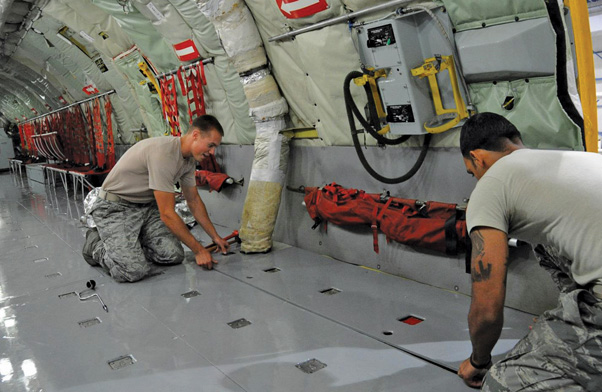March aircraft maintainers recently completed a full interior refurbishment on a KC-135 Stratotanker ahead of schedule, an accomplishment that was not an easy task, said Master Sgt. Brad A. Rosario, the Aircraft Structural Maintenance Refurbishment Supervisor from the 452nd Maintenance Squadron.
While March has accomplished several tanker refurbishments since 2011, this one is particularly memorable in light of the fact that an average aircraft refurbishment takes approximately 30 days. However, Stratotanker 3533 took this March team 23 days, finishing an entire week early.
“This is a serious job that requires a lot of work, and it’s nice to see everything come together at the end,” said Rosario.
The jet began its complete interior facelift July 27 with a hard-working crew of maintainers. Walking through the newly painted and upholstered jet, one would think the aircraft was fresh off the production line.
“These airplanes are well over 50-years-old and look like they are brand new after being refurbished,” said Staff Sgt. Caleb Meyer, an active duty crew chief assigned to the 752nd Maintenance Squadron, who worked on the refurbishment detail.
Interior refurbishments include repainting, replacing and resurfacing any interior parts that require it.
Painting is done by aircraft structural maintenance personnel, which requires extra training by maintainers, said Rosario. “The paint is highly toxic, so all of our people are required to be respirator certified.”
All aircraft floorboards had to be unscrewed and removed for resurfacing and repainting, which Rosario said was the most time-consuming task of the refurbishment. Additionally, all wall seats and other hanging objects had to be either removed and replaced or taped for the walls to be painted.
The crew cockpit is completely restored with all new carpet and newly-labeled decals, a tedious task that requires perfect precision, since the decals mark all pilot controls.
“It looks like a different plane entirely when we are finished,” Rosario said.
As Total Force Integration is becoming the model approach for March, this refurbishment was an example of the program’s success, said Meyers. The refurbishment team included traditional reservists, Air Reserve Technicians and active duty personnel.
“It’s important to have people who really care on your team when doing a refurbishment,” said Rosario who went on to talk highly of his TFI team members. “This is a good group of guys. It’s definitely a team effort, and it’s neat to see other shops and AFSCs (Air Force Specialty Codes) come together to accomplish one mission.”
Although there are currently none scheduled, aircraft get refurbished as needed and as mission schedules allow.
For a period of time, March was part of the Regional Refurbishment program, completing all 4th Air Force tanker refurbishments. This included taking in jets from Seymour Johnson Air Force Base, N.C., Joint Base Andrews, Maryland, and Tinker AFB, Oklahoma, said Rosario. However, due to stringent fiscal restraints, the program has since drawn down.




